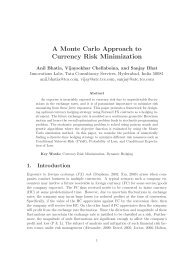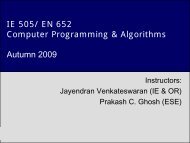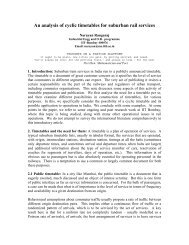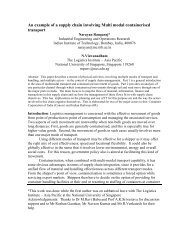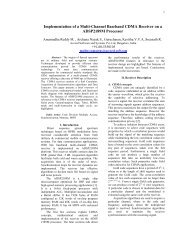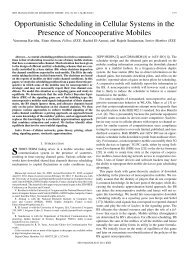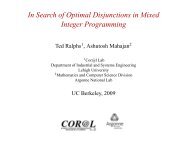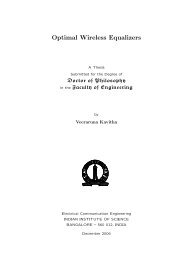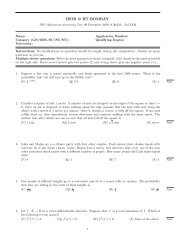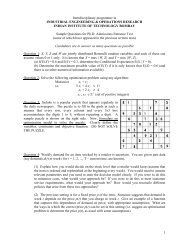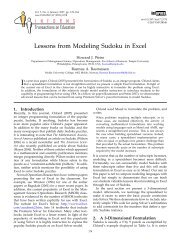Node capacity and terminal management on Indian Railways
Node capacity and terminal management on Indian Railways
Node capacity and terminal management on Indian Railways
Create successful ePaper yourself
Turn your PDF publications into a flip-book with our unique Google optimized e-Paper software.
Jose et al use a c<strong>on</strong>straint-based model to manage situati<strong>on</strong>s where normal operati<strong>on</strong>s are disrupted. This<br />
model attacks some situati<strong>on</strong>s where line <str<strong>on</strong>g>management</str<strong>on</strong>g>, involving traffic al<strong>on</strong>g a small number of lines is<br />
needed. The problem is modeled as a c<strong>on</strong>straint satisfying optimisati<strong>on</strong> problem. The model requires<br />
locati<strong>on</strong> data like locati<strong>on</strong> type (line or stati<strong>on</strong>) <str<strong>on</strong>g>and</str<strong>on</strong>g> <str<strong>on</strong>g>capacity</str<strong>on</strong>g>, train data like train type <str<strong>on</strong>g>and</str<strong>on</strong>g> priority <str<strong>on</strong>g>and</str<strong>on</strong>g><br />
some other data like time spent by a train <strong>on</strong> the locati<strong>on</strong>.<br />
6. Some work at IIT Bombay <strong>on</strong> modeling of railway traffic through secti<strong>on</strong>s <str<strong>on</strong>g>and</str<strong>on</strong>g><br />
nodes/<str<strong>on</strong>g>terminal</str<strong>on</strong>g>s<br />
In this secti<strong>on</strong>, we briefly look at some past <str<strong>on</strong>g>and</str<strong>on</strong>g> <strong>on</strong>going academic research at IIT Bombay, in this area.<br />
6.1 Secti<strong>on</strong> <str<strong>on</strong>g>capacity</str<strong>on</strong>g>: In the area of secti<strong>on</strong> <str<strong>on</strong>g>capacity</str<strong>on</strong>g> assessment, a simulati<strong>on</strong> tool is being developed<br />
for <strong>Indian</strong> <strong>Railways</strong> Institute of Signal Engineering <str<strong>on</strong>g>and</str<strong>on</strong>g> Telecommunicati<strong>on</strong>s (IRISET). This tool will<br />
permit numerical simulati<strong>on</strong> <str<strong>on</strong>g>and</str<strong>on</strong>g> experimentati<strong>on</strong> that will examine a variety of traffic <str<strong>on</strong>g>and</str<strong>on</strong>g> investment<br />
scenarios. The special feature of the model is that it permits modeling of automatic signaling<br />
investments <str<strong>on</strong>g>and</str<strong>on</strong>g> evaluates the performance of a secti<strong>on</strong> in two unique dimensi<strong>on</strong>s (i) speeds that depend<br />
<strong>on</strong> signal aspect <str<strong>on</strong>g>and</str<strong>on</strong>g> (ii) impact of signal failures. Apart from this, parametric experimentati<strong>on</strong> is<br />
possible with block secti<strong>on</strong> lengths, freight train speeds, number <str<strong>on</strong>g>and</str<strong>on</strong>g> accessibility of loops, loop turnout<br />
velocity <str<strong>on</strong>g>and</str<strong>on</strong>g> other parameters of typical interest. The tool has a graphical user interface as well as a<br />
charting procedure for validating train positi<strong>on</strong>s, signal aspects <str<strong>on</strong>g>and</str<strong>on</strong>g> velocities. The major output<br />
statistics are the average secti<strong>on</strong> traversal times for unscheduled freight trains <str<strong>on</strong>g>and</str<strong>on</strong>g> loop occupancy<br />
measures.<br />
The work d<strong>on</strong>e <strong>on</strong> secti<strong>on</strong> <str<strong>on</strong>g>capacity</str<strong>on</strong>g> at IIT Bombay can be found in Malik (1999) , Ashok Kumar<br />
(2000), Goswami (2001), Naik (2002).<br />
6.2 <str<strong>on</strong>g>Node</str<strong>on</strong>g> <str<strong>on</strong>g>capacity</str<strong>on</strong>g>: We describe two models below, which attempt to look at the h<str<strong>on</strong>g>and</str<strong>on</strong>g>ling of rail traffic<br />
through nodes, juncti<strong>on</strong>s or <str<strong>on</strong>g>terminal</str<strong>on</strong>g> stati<strong>on</strong>s <strong>on</strong> a railway network.<br />
1) Malde (2001) describes a detailed model al<strong>on</strong>g with a software implementati<strong>on</strong> of the routing of<br />
traffic through a node <str<strong>on</strong>g>and</str<strong>on</strong>g> creating a schedule of movements. The model is a general <strong>on</strong>e, which is<br />
designed to find a feasible timetable for trains with certain characteristics over a railway secti<strong>on</strong> that<br />
includes track secti<strong>on</strong>s <str<strong>on</strong>g>and</str<strong>on</strong>g> stati<strong>on</strong>s. It has sufficient detail in route selecti<strong>on</strong> to make it useful for<br />
modeling traffic through <str<strong>on</strong>g>terminal</str<strong>on</strong>g>s or juncti<strong>on</strong> stati<strong>on</strong>s. The general form of the model is shown to be<br />
theoretically difficult <strong>on</strong>e to solve exactly, <str<strong>on</strong>g>and</str<strong>on</strong>g> what is proposed is a heuristic which takes trains <strong>on</strong>e at a<br />
time according to a priority <str<strong>on</strong>g>and</str<strong>on</strong>g> finds feasible paths (if available), through the network in questi<strong>on</strong>.<br />
The model allows the specificati<strong>on</strong> of alternate routes for traffic streams through various track segments,<br />
<str<strong>on</strong>g>and</str<strong>on</strong>g> selects the shortest possible such route for each unit of traffic <str<strong>on</strong>g>and</str<strong>on</strong>g> then calculates a feasible schedule<br />
for a known set of trains through a node. Passenger trains with scheduled times at departure nodes can<br />
be specified as part of the input. Trains over track segments move with a specified speed. The trains are<br />
taken up in the order of a pre-specified priority. Crossovers are modeled al<strong>on</strong>g with their intersecti<strong>on</strong><br />
with various block secti<strong>on</strong>s.



